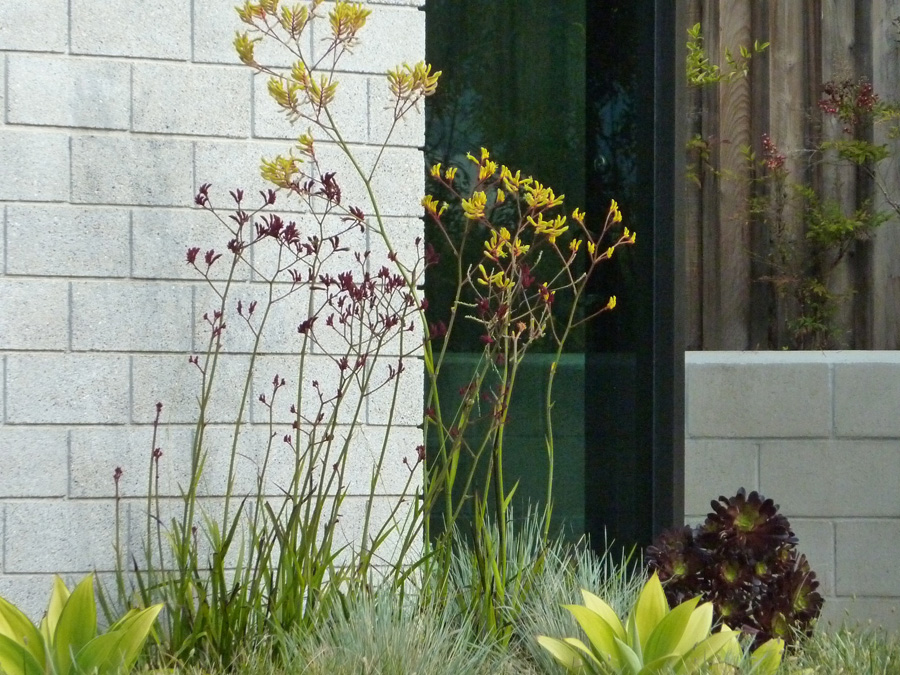Turf Free Zone
The rain doesn’t fall much in California so ditching the lawn in favour of less water-hungry plants makes sense. Particularly when the replacement is as creative as this front garden.
It’s probably fair to say that behind most pristine, nonsynthetic lawns lie a serious water habit, an active rake – if not a leaf blower – and possibly a petrol-guzzling mower and good dose of fertiliser. Climate change, particularly enduring drought and water restrictions, is, however, calling into question this impulse to have a private patch of nature in our front yards.
Californian landscape architect, Jack Kiesel, is interested in reinventing the “suburban lawn” for the twenty-first century rather than discarding the concept altogether. His residential garden design for the Van Hoy family, on the Mesa, Santa Barbara, shows how this can be done with clever planting and playfulness in equal measure.
There were two conceptual starting points for the Van Hoy project: the clients’ aesthetic wishes and Kiesel’s own design folly, with a message. “The client, who is an architect, wanted an artfully rendered garden, free-flowing and softly textured, to contrast with the contemporary lines and materials of his house,” says Kiesel.
An undulating landscape design started with the concept of a running stream. “I wanted to use low-growing plant materials, gravel and pavers instead of actual water to represent a stream,” says Kiesel.
The clients trusted Kiesel to realise his playful vision all the way through to implementation. “It doesn’t always happen that way,” says Kiesel. “People can get cold feet towards the end and opt to go with something more conservative.”
Kiesel used plants that, once established, would have drought tolerance. These ultimately hardy plants were used to represent water, an increasingly precious resource, and provide strong colours and textures. Thus rose pink, bluegray and a range of greens contrast vividly with the house’s neutral brick.
Dark coloured plants, like Echeveria “Afterglow”, were used to represent the deep inner parts of the stream; Elijah Blue Fescue (Festuca “Elijah Blue”) was recruited for the shallows; and taller, dark green (Sesleria ) grass was used to represent the stream banks.
Mini islands and the outer edges of the garden were primarily created from Blue Oat Grass (Helictotrichon sempervirens ), with highlights of Blue Foxtail Agave (Agave attenuate “Nova”), Variegated Fox Agave (Agave attenuate “Kara’s Stripes”), Pinwheel (Aeonium “Zwartkop”), Orange Libertia (Libertia peregrinans ), clumping Blue Bamboo (Himalayacalamus hookerianus ) and Big Red Kangaroo Paw (Anigozanthos “Big Red”).
The garden’s “hardscape” was designed to blend with the “soft” landscaping as much as possible. The driveway and path leading up to the house’s main entrance are made from precast pavers set on mortar beds to maintain stability. These pavers are surrounded by deep green “Surfgreen” gravel mulch, mined from a nearby inland quarry. Small clumps of bunch grass were planted between the slightly sunken pavers to provide continuity to the space and facilitate the driveway’s disappearance into the landscape.
The project is representative of landscape architect’s work in a number of ways: “I like my gardens to be practical, to follow the ‘form follows function’ principle,” says Kiesel. “They are also artistically expressive and my intention is to make them as sustainable as possible.”
He is also quick to reinforce that the success of the Van Hoy’s fabulous lawn is not only attributable to the strength of the concept and its execution, but also to the strength of the client-designer relationship. “If the clients are not on board with what you are doing, it just doesn’t work. The projects that turn out the best are the ones where the clients are willing to trust the architect and take risks with their landscape.”
The landscape architect aspires to bring nature back into “our out-dated monocultured mow-and-blow neighbourhoods”. His own garden is composed of native Californian plants. “The wildflowers are currently putting on a show and being appreciated by the neighbours, most of whom still have traditional lawns. Change can be slow,” says Kiesel. “Native plants, whether in Australia or California, offer great wildlife value and drought tolerance and they are beautiful to boot.”
Kiesel’s alternative vision for the traditional lawn goes even further: “I imagine one day being able to link urban native gardens back to the outer edges of our wild lands through wildlife corridors. Wouldn’t this be so much more interesting and sustainable than the bright green water starved turf-scapes you typically see now?”










